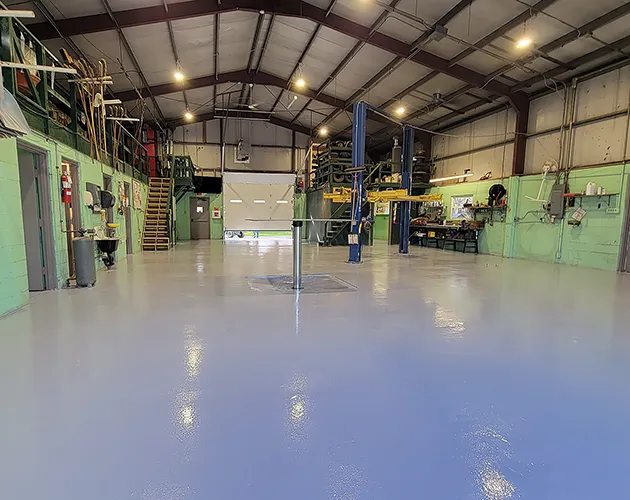Novolac Epoxy on Service Bay Floor in Camp Hill, PA
Coatings were reinforced with sand.
Camp Hill Service Bay Commercial Floor Coated
This service bay in Camp Hill, Pennsylvania was coated by STRONGHOLD FLOORS with Novolac epoxy. Sand was added to strengthen the coatings' performance.
The company's original commercial floor paint was failing in many areas, and at some points, was completely gone. They needed a coating that would protect the concrete from chemical attack while also allowing clear visibility to find dropped items. The company decided on Novolac epoxy for its high abrasion resistance and chemical resistance. While Novolac can be combined with other systems such as decorative chip or decorative quartz, they settled on medium gray, solid color epoxy for its visibility.
Read on to learn what steps were involved in the four day process of installing these commercial floor coatings with pictures, or check out the video below.
Day One (Surface Prep)
On the first day of this coatings project, the concrete surface was prepared. This process involved mechanically diamond grinding the concrete with two walk-behind machines for the larger areas of concrete. In the places where the machine couldn't reach (such as edges, corners, or beneath tables), hand grinders were used.
In some of the rooms, the floor was tiled. Special tools were used to rip the tiles off, exposing the concrete (and some of the old floor paint) for preparation. The pictures below are in order during the first day.
Day Two (Repairs and Primer)
On the second day, the team vacuumed any remaining concrete dust from the previous day's surface prep. Once the dust was removed, epoxy crack fillers were put into cracks to repair the concrete surface. After filling in the cracks, the team applied a primer base coat of solid color epoxy. Brushes were used for edges and beneath tables. The first picture shows the results of day one's work.
Day Three (Repairs, Second Coat, and Sand)
On the third day, any remaining cracks or surface imperfections were filled with fast-setting epoxy. Once the surface was repaired, a second coat of medium gray epoxy was applied over the primer. Sand was then broadcasted over the "wet" coating until it was completely saturated (not pictured). The addition of sand in this coating system increases the build (thickness) & compressive strength of the system.
Day Four (Novolac Epoxy)
On the final day, the team first removed any sand that did not bond with the coating. Novolac epoxy was then applied over top of the prior coatings and the sand.




































